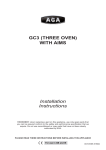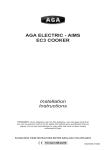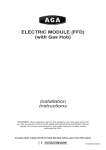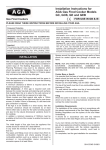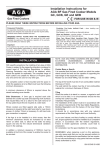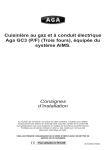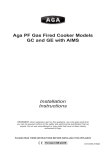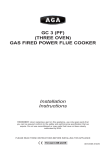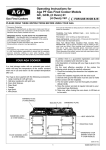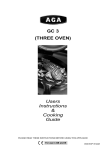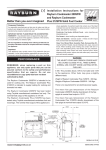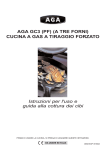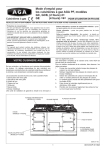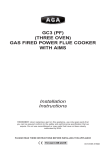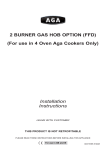Download AGA GC 3 Technical data
Transcript
GC 3 (THREE OVEN) Installation Instructions REMEMBER: when replacing a part on this appliance, use only spare parts that you can be assured conform to the safety and performance specification that we require. Do not use reconditioned or copy parts that have not been clearly authorised by AGA. PLEASE READ THESE INSTRUCTIONS BEFORE INSTALLING THIS APPLIANCE For use in GB and IE 09/10 EINS 512427 CONTENTS SECTION PAGE HEALTH & SAFETY 3 INSTALLATION 4 LOCATION 4 TECHNICAL DATA - 3 OVEN AGA (GC3) ONLY 5 TECHNICAL DATA - 3 OVEN AGA WITH MODULE (GC3M) 6 TECHNICAL DATA - CONTINUED 7 FLUE SYSTEM 8 INSTALLATION PIPES 8 AIR SUPPLY 8 BAKING OVEN BAFFLE PLATE 8 COMMISSIONING 9 - 11 INSTRUCTIONS 11 2 HEALTH & SAFETY Consumer Protection As responsible manufacturers we take care to make sure that our products are designed and constructed to meet the required safety standards when properly installed and used. IMPORTANT NOTICE: PLEASE READ THE ACCOMPANYING WARRANTY. Any alteration that is not approved by AGA could invalidate the approval of the appliance, operation of the warranty and could affect your statutory rights. Important This appliance may contain some of the materials that are indicated. It is the Users/Installers responsibility to ensure that the necessary personal protective clothing is worn when handling, where applicable, the pertinent parts that contain any of the listed materials that could be interpreted as being injurious to health and safety, see below for information. Firebricks, Fuel beds, Artificial Fuels - when handling use disposable gloves. Fire Cement - when handling use disposable gloves. Glues and Sealants - exercise caution - if these are still in liquid form use face mask and disposable gloves. Glass Yarn, Mineral Wool, Insulation Pads, Ceramic Fibre, Kerosene Oil - may be harmful if inhaled, may be irritating to skin, eyes, nose and throat. When handling avoid inhaling and contact with skin or eyes. Use disposable gloves, face-masks and eye protection. After handling wash hands and other exposed parts. When disposing of the product, reduce dust with water spray, ensure that parts are securely wrapped. 3 INSTALLATION With specific exceptions, the installing of any type of AGA cooker is subject to the respective directions contained in current issue of The Building Regulations. In addition, Planning Permission may need to be obtained, which should be applied for separately. The complete range of AGA cookers are suitable for Natural or Propane gases only and cannot be used on any other gas. (IMPORTANT: See data plate which is situated on burner housing panel behind top left door). The complete cooker is floor-mounted and the space in which the appliance is to be fitted must have the following minimum dimensions:A minimum clearance of 60mm is required above the raised insulating cover handle. Side Clearances: A 3mm gap is required each side between the cooker top plate and adjoining work surfaces that maybe fitted, this is to allow for the safe removal of the top plate should this be required at a later date. Where cookers are fitted against side walls a clearance of 116mm is required at the right hand side for oven doors access. (A further 116mm is necessary if a left hand side gas connection is required). If the Aga is to be installed in a brick recess, then the minimum clearance should be increased by at least 10mm on either side, to allow for the walls not being square and also for the natural dimensional variations found in the castings. In addition a minimum clearance of 1000mm must be available at the front of the cooker to enable the cooker to be serviced. The initial length of flue pipe from the appliance flue socket should be vertical for at least 600mm. In any event the minimum flue length must not be less than 3m. Flue pipes and fittings must not be closer than 25mm to combustible materials and where passing through a combustible partition such as a ceiling or roof, must be enclosed in a noncombustible sleeve providing a connector space of at least 25mm. Spaces around flue pipes and passing through walls or floors should be sealed against the passage of smoke and flame. NOTE: AGA GAS FIRED COOKERS ARE DELIVERED EX-WORKS UNASSEMBLED. ASSEMBLY IS UNDERTAKEN ON SITE BY THE AUTHORISED AGA DISTRIBUTOR. Cooker Base or Hearth It is essential that the base or hearth on which the cooker stands should be level and be capable of supporting the total weight of the cooker. Model GC3 - 477 Kg The top of the hearth must be of non-combustible material thickness of 12mm. The wall behind the cooker must be of non-combustible material for a minimum thickness of 25mm. Tiling When the cooker is to stand in a recess, or against a wall which is to be tiled, in no circumstances should the tiles overlap the cooker top plate. Installation Requirements The installation of the cooker must be in accordance with the relevant requirements of the Gas Safety Regulations, Building Regulations and the bylaws of the local Water Undertaking. It should be in accordance also with any relevant requirements of the Gas Region and Local Authority. In your own interest, and that of safety to comply with the law, all gas appliances should be installed by a competent person, in accordance with the relative regulations. Failure to install appliances correctly could lead to prosecution. On completion, test the gas installation for soundness. LOCATION The location chosen for the appliance must permit the provision of a satisfactory flue and an adequate air supply. The location must also provide adequate space for servicing and air circulation around the cooker. 4 TECHNICAL DATA - 3 OVEN AGA (GC3) ONLY FIG. 1 DESN 512841 B A B C D E F G H J K L M N mm 987 889 851 679 467 1035 41 1330 756 1125 73 39 3 P W 698 116 PLEASE NOTE: SIDE CLEARANCE DIMENSION W IS ALSO REQUIRED ON THE LH SIDE FOR THE BAKING OVEN DOOR. COOKER DIMENSIONS When surveying for a cooker installation the actual clearance required for the ‘body’ of the appliance should be increased overall by 10mm beyond the figures quoted below. This allows safe margin to take into account the natural dimensional variations found in major castings. In particular the width across the appliance recess could be critical. GAS CONNECTION GC3 ONLY 1/4” BSP supply pipe, with 1/4” BSP to 15mm fitting provided. GAS CONNECTION GC3M WITH MODULE (IF FITTED) See Fig. 1A, (page 6), and refer to Module Installation Instructions. 5 TECHNICAL DATA - 3 OVEN AGA WITH MODULE (GC3M) FIG. 1A - GAS SUPPLY CONNECTIONS (APPROXIMATE POSITIONS) NOTE: 1/4” BSP to 15mm fitting provided. 6 DESN 512449 TECHNICAL DATA (CONTINUED) Models GC3 Standard Flue GC3 NATURAL G20 MAXIMUM HEAT INPUT Thermostat Bypass Main Burner Injector Pilot Injector Inlet Pressure Burner Pressure 5kW 100 or 120 400 4212 20mbar 10mbar PROPANE G31 5kW(357g/h) 60 or 80 170 4209 37mbar 25mbar MAXIMUM HEAT INPUT Thermostat Bypass Main Burner Injector Pilot Injector Inlet Pressure Burner Pressure 7 FLUE SYSTEM The following notes are intended to give general guidance:The initial length of flue pipe from the appliance flue socket should be vertical for at least 600mm. In any event, the minimum flue length must not be less than 3m. The cross-sectional area of the flue serving the cooker must not be less than the area of the flue outlet of the cooker. If the flue pipe is to be used then, it must not be less than 100mm internal diameter. Flue pipes and fittings should be constructed from one of the following materials:a) b) c) Cement Aluminium or Stainless Steel Cast iron or mild steel, acid resistant vitreous enamel lined. If a chimney is to be used it preferably should be one that is composed of or lined with noncombustible porous acid resistant material. (Chimneys lined with a salt glazed earthenware pipes are acceptable if pipes comply with the regulations in force). A flue pipe constructed from one of the materials in (a) to (c) above, should form the initial connection to lined chimneys. Where a chimney is to be used which is not composed of or lined with a non-porous acid resistant material it should be lined with a stainless steel flexible flue liner. The internal diameter of the liner must not be less than 100mm. A flue pipe which is constructed from one of the materials in (a) to (c) above should form the connection between the draught diverter and flue liner. Before connecting the appliance to or inserting a liner into, a flue that has been previously used, the flue must be thoroughly swept clean of any soot and loose material. If a baffle is fitted in the flue it must be removed before connecting the appliance to, or inserting a liner into the flue. The point of termination must not be within 600mm of an openable window, air vent or any other ventilation opening. INSTALLATION PIPES Installation pipes should be fitted in accordance with current Gas Regulations. Pipework from the meter to the cooker must be of adequate size, cooker connection size of 15mm Dia. On completion test the gas installation for soundness and purge in accordance with the regulations in force. AIR SUPPLY Kitchen or Internal Space Air Supply Where the appliance is to be installed in a kitchen or internal space, it does not require the kitchen or internal space containing it to have a permanent air vent. BAKING OVEN BAFFLE PLATE A metal plate (with square holes) which is provided in the Aga pack MUST be positioned on the top runners of the Baking Oven. Slide the plate in fully, until it makes contact with the back of the oven. This baffle is a permanent part of the Baking Oven, to regulate the oven temperature. 8 COMMISSIONING (2) (6) (3) (5) (4) FIG. 2 (1) DESN 512431 FIG. A FIG. B FIG. C FIG. D FIG. 3 9 COMMISSIONING (CONTINUED) LIGHTING THE BURNER - FIG. 2. CAUTION: NO SMOKING OR NAKED LIGHTS Open the outer burner door to expose the gas control combination valve. CAUTION: BEFORE LIGHTING: ENSURE THAT THE GAS VALVE CONTROL KNOB 2 IS SET IN THE OFF POSITION (SEE FIG. 3A) AND COMBUSTION DISCHARGE SAFETY DEVICE BUTTON 6 IS DEPRESSED. 1. Turn off union gas cock 1. Test the gas installation from the meter cock for soundness and purge. 2. Turn on gas supply and open gas cock 1. 3. Turn the gas valve control knob 2 anti-clockwise to the position ( ) (See Fig. 3B). Press down and hold the knob in the position while depressing the piezo ignitor 3 several times until the pilot has lit. This can be observed through the burner housing aperture. 4. When the pilot has lit continue to hold the gas valve control knob for approximately 30 seconds. If it goes out, wait 3 minutes and repeat the procedure holding for a little longer. 5. With the pilot flame established, rotate the gas valve control knob 2 anti-clockwise to its low fire position (See Fig. 3C). Where upon the main burner will automatically light. Leave in the low fire position for at least 30 minutes. 6. After 30 minutes rotate the control knob further anti-clockwise to the mid-position of the green band for normal running. (See Fig. 3D). NOTE: AFTER SEVERAL HOURS THE HEAT INDICATOR SHOULD BE ON OR ABOUT THE CENTRE OF THE SILVER SECTION. IT MAY BE NECESSARY TO ADJUST THE CONTROL KNOB SLIGHTLY IN THE GREEN BAND TO ACHIEVE THIS. IF THE FLAME HAS EXTINGUISHED FOR WHATEVER REASON, WAIT THREE MINUTES (MINIMUM) BEFORE RE-LIGHTING. 7. On the first lighting or if the cooker has been cold for a long time, moisture from the insulation may run down the enamelled front of the cooker. This should be wiped off to prevent staining. 8. Check the inlet gas pressure is as indicated in the data plate as follows. (i) Turn the gas valve control knob 2 to OFF position (See Fig. 3A). Remove the inlet pressure test nipple plug 4 and fit pressure gauge. Relight pilot (See No. 3 and 4) Turn gas valve control knob 2 to the mid-position of the green band. (ii) Check inlet pressure correctly corresponds to the data plate. (iii)Check that the gas pressure is unaffected when other gas appliances are used. (iv)Turn gas valve control knob 2 to ignition position (See Fig. 3B). Remove the pressure gauge and replace gas nipple plug. Turn gas valve control knob 2 to the mid-position of the green band for normal running. 10 COMMISSIONING (CONTINUED) 9. Check burner pressure as follows:Repeat instructions 8 on completely cold cooker with the pressure gauge fitted to the burner pressure test point 5. Check that the burner pressure correctly corresponds to the table on page 6. NOTE: IF FOR ANY REASON A GAS RATE CHECK IS REQUIRED, TURN OFF ALL OTHER APPLIANCES USING GAS, AND USING THE GAS METER TEST DIAL AND A STOP WATCH, CHECK THAT THE MAXIMUM GAS INPUT TO THE APPLIANCE IS AS INDICATED ON THE DATA PLATE. Once the correct setting has been confirmed, the heat control will operate automatically to maintain the cooker at full temperature. NOTE: REMEMBER TO NOTE THE SETTING POSITION IF TURNING OFF THE COOKER. TO EXTINGUISH THE BURNER Turn the gas valve control knob to the OFF position (See Fig. 3A). CHECK FOR CLEARANCE OF PRODUCTS OF COMBUSTION. Ensure that all doors and windows of the room are closed. Light the cooker as described. Leave on maximum rate for 5 minutes. If there is a fan in the same room or nearby, then the spillage test must be repeated with the fan turned on and any interconnecting doors between the cooker and the fan location open. A spillage test must be carried out after 5 minutes as follows: By holding a smoke match so that the match head is approximately 3mm up inside of the lower edge of the draught diverter. Spillage is indicated by the smoke being displaced outwards from the draught diverter. if in doubt repeat after a further 10 minutes. If the spillage is detected the chimney may be faulty. The combustion discharge safety device will have operated, the fault must be corrected before leaving the cooker installed, the device must be depressed before the Aga can be re-lit. If the fault cannot be corrected turn off and disconnect the gas supply to the cooker and seek expert advice. INSTRUCTIONS Hand these and the Operating Instructions to the User for retention and instruct in the safe operation of the appliance. Finally advise the User that, for continued efficient and safe operation of the appliance it is important that adequate servicing is carried out at regular intervals recommended by the AGA Distributor or local Gas Region. 11 For further advice or information contact your local AGA Specialist WithAGA’s policy of continuous product improvement, the Company reserves the right to change specifications and make modifications to the appliance described and illustrated at any time Manufactured by AGA Station Road Ketley Telford Shropshire TF1 5AQ England www.aga-web.co.uk www.agacookshop.co.uk www.agalinks.com 12












